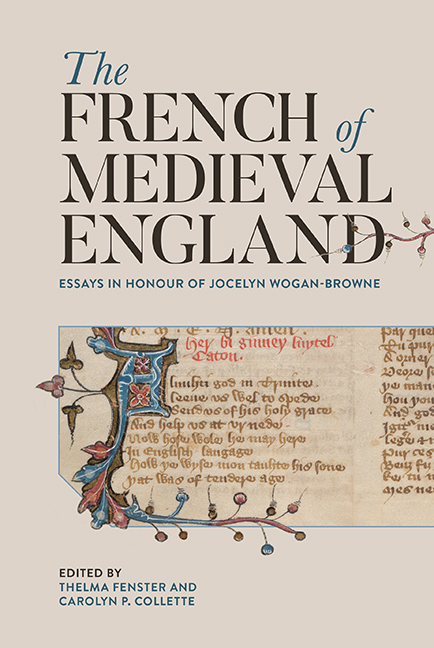Book contents
- Frontmatter
- Contents
- List of Illustrations
- List of Contributors
- List of Abbreviations
- Foreword: ‘The Light I Never Left Behind’: Jocelyn Wogan-Browne
- Introduction: Recognizing the French of Medieval England
- 1 The Gloss to Philippe de Thaon's Comput and the French of England's Beginnings
- 2 The Scandals of Medieval Translation: Thinking Difference in Francophone Texts and Manuscripts
- 3 Contrafacture and Translation: The Prisoner's Lament
- 4 Complaining about the King in French in Thomas Wright's Political Songs of England
- 5 The Chanson d’Aspremont in Bodmer 11 and Plantagenet Propaganda
- 6 The Use of Anglo-Norman in Day-to-Day Communication during the Anglo-Scottish Wars (1295–1314)
- 7 Middle English Borrowing from French: Nouns and Verbs of Interpersonal Cognition in the Early South English Legendary
- 8 William Langland Reads Robert Grosseteste
- 9 Disability Networks in the Campsey Manuscript
- 10 English Women and Their French Books: Teaching about the Jews in Medieval England
- 11 French Residents in England at the Start of the Hundred Years War: Learning English, Speaking English and Becoming English in 1346
- 12 French Immigrants and the French Language in Late-Medieval England
- 13 Fashioning a Useable Linguistic Past: The French of Medieval England and the Invention of a National Vernacular in Early Modern France
- 14 Admiring Ambivalence: on Paul Meyer's Anglo-Norman Scholarship
- 15 Twenty-First Century Gower: The Theology of Marriage in John Gower's Traitié and the Turn toward French
- 16 Royaumes sans frontières: The Place of England in the Long Twelfth Century
- Afterword
- Bibliography
- Index
- Publications of Jocelyn Wogan-Browne
- Tabula Gratulatoria
9 - Disability Networks in the Campsey Manuscript
Published online by Cambridge University Press: 12 August 2020
- Frontmatter
- Contents
- List of Illustrations
- List of Contributors
- List of Abbreviations
- Foreword: ‘The Light I Never Left Behind’: Jocelyn Wogan-Browne
- Introduction: Recognizing the French of Medieval England
- 1 The Gloss to Philippe de Thaon's Comput and the French of England's Beginnings
- 2 The Scandals of Medieval Translation: Thinking Difference in Francophone Texts and Manuscripts
- 3 Contrafacture and Translation: The Prisoner's Lament
- 4 Complaining about the King in French in Thomas Wright's Political Songs of England
- 5 The Chanson d’Aspremont in Bodmer 11 and Plantagenet Propaganda
- 6 The Use of Anglo-Norman in Day-to-Day Communication during the Anglo-Scottish Wars (1295–1314)
- 7 Middle English Borrowing from French: Nouns and Verbs of Interpersonal Cognition in the Early South English Legendary
- 8 William Langland Reads Robert Grosseteste
- 9 Disability Networks in the Campsey Manuscript
- 10 English Women and Their French Books: Teaching about the Jews in Medieval England
- 11 French Residents in England at the Start of the Hundred Years War: Learning English, Speaking English and Becoming English in 1346
- 12 French Immigrants and the French Language in Late-Medieval England
- 13 Fashioning a Useable Linguistic Past: The French of Medieval England and the Invention of a National Vernacular in Early Modern France
- 14 Admiring Ambivalence: on Paul Meyer's Anglo-Norman Scholarship
- 15 Twenty-First Century Gower: The Theology of Marriage in John Gower's Traitié and the Turn toward French
- 16 Royaumes sans frontières: The Place of England in the Long Twelfth Century
- Afterword
- Bibliography
- Index
- Publications of Jocelyn Wogan-Browne
- Tabula Gratulatoria
Summary
A paralyzed woman from distant Wales arrives at the shrine of St Osith in southern Essex, at the end of a long sequence of pilgrimages by which she has sought a cure at cult sites all over England. Even at the great Abbey of Bury St Edmunds, the last site she knew of, the Welsh woman has learned in a dream from St Edmund himself that she will be cured only if she makes yet one further journey, to watch and pray at the church of St Osith. She thanks her dream counselor, but adds:
‘Icest respons trop mei desheite,
Kar cher sire, ceo sachiez bien,
De seinte Osith ne say jeo rien,
Ne sai u est ne en quele terre …’
(‘This answer greatly discourages me, for, dear sir, you may know that I have never heard of St Osith nor do I know anything about her. I don't know where she is, nor in what country, nor do I know where to seek St Osith’; lines 1161–64)
The next morning, though, some chance passers-by are able to tell her the way to this apparently obscure site, and the crippled woman convinces her exhausted circle of care-givers to make a last, eight-day journey to St Osith's church at Chich, where the pilgrim is, indeed, cured after a night praying at the shrine.
This crucial episode, to which this essay will return, occurs in the Life of Saint Osith, Virgin and Martyr (La Vie Seinte Osith, Virge et Martire), its unique copy surviving in a collection of thirteen saints’ lives now widely called the Campsey manuscript (London, British Library, MS Additional 70513); all of them are written in the French of England. The crippled woman's story provides one particularly dense node in a rich, surprisingly varied network of disabilities and cures that ramifies among the Campsey saints’ lives. The anecdote may also serve as an initial emblem for the overlapping lost-and-found histories that have led to our current, still emerging knowledge of the French of England, and of the medieval disability culture that permeates so much of medieval art and literature.
- Type
- Chapter
- Information
- The French of Medieval EnglandEssays in Honour of Jocelyn Wogan-Browne, pp. 157 - 174Publisher: Boydell & BrewerPrint publication year: 2017

